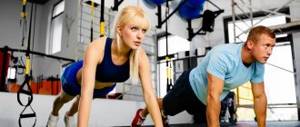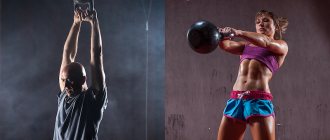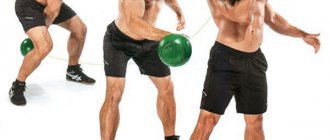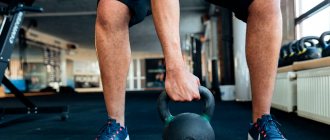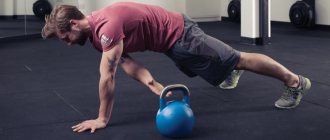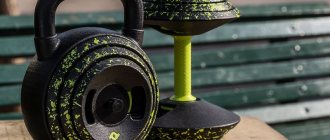Kettlebell swings (or swings) are an exercise that migrated to CrossFit from kettlebell lifting. Only those who are completely far from strength sports disciplines have not noticed how much the popularity of the Russian apparatus has grown over the past few years. The reason is the enormous potential of kettlebells, their ability to turn a fragile gym goer into a strong and resilient athlete in a short time.
What muscles work?
The main load when performing kettlebell swings falls on:
- gluteal muscles,
- hamstrings,
- quadriceps,
- lumbar back,
- abdominal Press.
The movement is inertial in nature - the role of the hands is secondary. At the start, the tone of the swing is set by the legs; the final result depends on their strength and coordination. The exercise is focused on the legs - swings are a good help for athletes who practice squats and deadlifts. The inertia given by the legs and abs is enough for approximately 70-80 percent amplitude. On the last leg of the journey, the front deltoids come into play. The task of this muscle group is to bring the trajectory to its logical conclusion, that is, to allow the weights to end up at face level or just above the head.
The projectile is held with the hands, so the “grasping” muscles are also of considerable importance. But CrossFit doesn't use overly heavy kettlebells, so it doesn't require enormous grip strength. However, the hands are used all the time, which cannot but have a positive effect on their strengthening.
On the other hand, if grip strength is one of the goals, swings can easily accomplish the goal. Weightlifters are famous for their powerful hands. One of the criteria for determining the quality of skis is curious. Experts recommend placing the backs of your skis next to each other. Since the runners bend, there should be a small gap between the attached structures. Good runners are distinguished by the fact that the skier is not able to squeeze them so that the gap disappears. But! This test works with everyone except weight lifters - this is emphasized by managers of sports stores.
What are the benefits of swinging kettlebells with two hands?
A simple exercise allows you to solve a whole range of problems:
- Strengthen the muscles of the “posterior chain” - calves, hamstrings, buttocks, longus dorsi and latissimus muscles to correct office-type posture and relieve us of back pain;
- The benefits of kettlebell swings for the formation of beautiful buttocks are invaluable. The movement engages both fast-twitch and slow-twitch muscle fibers and helps build shape and size quickly;
- Prepares for performing deadlifts from the floor in the classic style and helps to establish safe technique for a beginner without unnecessary problems;
- Improves the mobility of the hip and ankle joints, serves as the prevention of injuries in runners and cardio lovers;
- Allows you to progress in “related” exercises – deep squats and deadlifts.
Pavel Tsatsouline says that the kettlebell swing is one exercise that can replace a whole complex for a beginner. It is enough to perform 10-15 swings every 90 seconds for 20 minutes to give a great workout to your back and legs.
Benefits of exercise
The classic Russian apparatus is universal, and swings with a kettlebell are a multifunctional exercise. Therefore, the benefits of swings are enormous. This movement is mandatory in kettlebell lifting and is encouraged in CrossFit, mixed martial arts and other sports disciplines.
Benefits of kettlebell swings:
- development of explosive strength (primarily legs),
- strengthening all major muscle groups,
- development of strength endurance,
- preparing the body for squats, deadlifts and push pushes of the barbell, this applies to both strength indicators and the technical side - with the help of swings, good technique is developed,
- improving the functioning of the cardiovascular system,
- the opportunity to diversify the training program.
There are many advantages. But you also need to remember about the limitations. Kettlebell swings are contraindicated for problems with the lower back, shoulder and hip joints, and hands. Pain or even relatively minor discomfort is a reason to refrain from doing this exercise.
Alternative Substitutes for the One-Arm Kettlebell Snatch
One of these exercises is the Kettlebell Swing with two hands - this is an exercise that came to CrossFit from kettlebell lifting. The exercise strengthens the muscles of the thighs, is aimed at developing strength and endurance, it is considered easy to perform and strengthens the entire shoulder core.
Swing kettlebells with two hands
Handstand push-ups are also an exercise that focuses on the deltoids. When performing these push-ups, you lift 100 percent of your body weight.
Strict handstand push-ups
The two kettlebell snatch is a similar exercise, but more complex in technique because it uses both arms. We advise you to learn the kettlebell snatch with one hand, and then start snatching two kettlebells.
Snatch of two weights
Auxiliary exercises
Let's look at a few exercises to do before you begin the one-arm kettlebell snatch.
Russian Kettlebell Swings The kettlebell swing is a powerful exercise that develops explosive strength and strengthens the muscles of the hips, back and buttocks. It is considered a guide, as it helps to develop the correct technique for moving the pelvis during the swing and lift.
Russian kettlebell swings
Army barbell standing press. This exercise is aimed at working the muscles of the shoulder body, as well as developing coordination. These aspects are essential when performing the kettlebell snatch.
Standing barbell press (military)
The kettlebell snatch is a competitive exercise in kettlebell lifting. The following are tables of grade standards for men and women for 2018-2021.
TABLE OF DIFFERENT STANDARDS FOR MEN:
1. Double event (the number of points scored in 10 minutes in each exercise)* points are awarded: for 1 kettlebell push - 1 point, for 1 kettlebell jerk - 0.5 points
| Weight category (kilogram) | MSMKettlebell 32kg | MSgirya 32kg | KMSweight 32kg | Kettlebell 24kg | II kettlebell 24kg | III weight 24kg | I(u)weight 16kg | II(u) kettlebell 16kg | III(u) kettlebell 16kg |
| 48 | – | – | – | – | – | – | 110 | 75 | 50 |
| 53 | – | – | – | – | – | – | 120 | 85 | 55 |
| 58 | – | – | – | 90 | 70 | 50 | 130 | 95 | 60 |
| 63 | 192 | 126 | 75 | 100 | 80 | 60 | 140 | 105 | 65 |
| 68 | 210 | 146 | 83 | 110 | 90 | 65 | 150 | 110 | 70 |
| 73 | 222 | 162 | 95 | 120 | 95 | 70 | 160 | 120 | 75 |
| 73+ | – | – | – | – | – | – | 170 | 125 | 80 |
| 78 | – | – | – | 130 | 105 | 80 | – | – | – |
| 85 | 234 | 178 | 117 | 140 | 110 | 85 | – | – | – |
| 85+ | 246 | 190 | 126 | 160 | 130 | 100 | – | – | – |
TABLE OF DIFFERENT STANDARDS FOR WOMEN:
2. Snatch (number of weight lifts in 10 minutes)
| Weight category (kilogram) | MSMKettlebell 24kg | MSgirya 24kg | KMSweight 24kg | Kettlebell 16kg | II kettlebell 16kg | III weight 16kg | I(u)weight 16kg | II(u) kettlebell 16kg | III(u) kettlebell 16kg |
| 48 | – | – | – | 80 | 60 | 45 | 43 | 33 | 23 |
| 53 | – | – | – | 90 | 70 | 50 | 45 | 35 | 25 |
| 58 | – | – | – | 100 | 80 | 60 | 55 | 45 | 35 |
| 63 | 159 | 126 | 73 | 110 | 90 | 70 | 65 | 55 | 45 |
| 63+ | 181 | 146 | 86 | 125 | 100 | 85 | 75 | 65 | 55 |
In the GTO standards, you can also find a one-handed kettlebell snatch for men. The following are the gold, silver and bronze medal standards for different ages.
| Bronze | Silver | Gold | |
| from 18 to 24 years old | 21 | 25 | 43 |
| from 25 to 29 years old | 19 | 23 | 40 |
| from 30 to 34 years old | 19 | 22 | 39 |
| from 35 to 39 years old | 18 | 21 | 37 |
| from 40 to 44 years old | 14 | 17 | 28 |
| from 45 to 49 years old | 9 | 11 | 23 |
| from 50 to 54 years old | 8 | 10 | 20 |
| from 55 to 59 years old | 6 | 8 | 18 |
Execution technique
Both the result and the health of muscles and joints depend on proper execution. Let's look at how to perform the swing exercise with a kettlebell correctly.
Technique:
- starting position (IP) – feet shoulder-width apart, pelvis laid back, knees slightly bent, back straight, the apparatus is in front of the feet at a distance equal to the length of the foot,
- keeping your back straight, grab the kettlebell with both hands, lift it off the floor and swing it back, behind the line of the pelvis, in the lower phase the body is almost parallel to the floor, the movement is performed mainly by the force generated by the rotation of the hip joints, flexion and extension of the knee joints is slight ,
- after swinging back, with a powerful force of the pelvis and legs, push the weight forward and up, arms are straight, slightly bent at the elbows, in the starting phase of the lift, the load from the heels is transferred to the front of the feet, the projectile is accelerated due to the accentuated contraction of the gluteal muscles and the movement of the pelvis, the knees bend and slightly lean forward
- after the weight is at the level of the solar plexus, it is necessary to connect the front deltoids and bring the projectile to the level of the face, another variation involves a peak point slightly above the head, the higher the weight flies, the greater the load falls on the shoulder joints,
- allow the apparatus to return to the IP, the weight lowers mainly due to inertia, but the gluteal muscles must be constantly tense,
- Without letting the kettlebell get too far behind your back, do the next rep.
Thus, it is necessary to perform a specified number of repetitions or swing weights for the planned time. We considered the option with one kettlebell and two hands. There are other variations:
- with two projectiles in both hands,
- with one projectile with one hand (alternately).
In the first case, it is necessary to additionally coordinate the work of the hands. The second variation also branches - the order varies. For example, you can change hands as you reach fatigue or with each repetition.
Legs
Goblet Squats
The first type of squats focuses on the quadriceps. Also, a good load goes to the gluteal muscles. The hamstrings, calves, spinal erectors and abs work as stabilizers.
The technique is:
- Take the kettlebell by the handle on your sides with both hands, stand straight, feet slightly wider than shoulder-width apart, toes pointing slightly to the sides.
- Without changing the angle of your back or hunching, squat so that your thighs form an acute angle with your shins, that is, below parallel. At the same time, try not to let your knees go ahead of your toes.
- Get into the starting position, do not bring your knees together when lifting. Do not straighten your legs all the way; begin the next repetition immediately.
A variation of this exercise can be called a squat with a kettlebell on outstretched arms. Here, it will most likely be easier for you to catch your balance, but it is more difficult to hold the projectile - only the front deltoids work on this.
georgerudy - stock.adobe.com
Experienced athletes can perform the movement with two kettlebells, thus increasing the load on the legs.
Plie squats
Here the load shifts to the adductor muscles of the thigh (inner part), as well as the gluteal muscles. The quadriceps also works, but less.
Technique:
- Place your feet significantly wider than your shoulders, and also turn your toes to the sides. The projectile is in your hands down, it will be easier to hold it here.
- As you inhale, lower yourself slowly, as if sitting on a chair. At the same time, your knees point in the same direction as your socks, do not bring them together.
- Lower yourself to a comfortable depth and, as you exhale, begin to rise, straightening your knee and hip joints. Also make sure that your back does not round and your knees do not go past your toes.
Vitaly Sova — stock.adobe.com
To make the exercise more difficult, you can hold a weight in each hand.
Single leg squats
Another name for the exercise is “pistol.” In this case, it is performed with weights - a kettlebell, which must be held with arms outstretched forward. Not suitable for a beginner, but for more experienced athletes it is an excellent movement that allows you to pump up the muscles of the legs and buttocks, as well as develop coordination and dexterity.
ifitos2013 – stock.adobe.com
To practice the exercise, you first need to learn how to correctly perform a regular squat, then on one leg without weights (you can sit on a sofa or hold onto a support with one hand) and only then proceed to the most difficult option.
Lunges with kettlebells
Lunges are a versatile exercise for the lower body. The quadriceps, hamstrings and glutes work here. At the same time, the front part of the thigh works more with a narrow and medium step, and the back and buttocks work more with a wide step.
In general, the technique is as follows:
- Take the apparatus in your hands, stand straight with your feet together.
- Take a step forward with your left foot, lower yourself down until your right knee almost touches the floor. It is not necessary to touch - just go down to the greatest depth. In this case, the angle between the thigh and shin of both legs should be 90 degrees.
- Return to the starting position and lunge with your right leg.
djile - stock.adobe.com
Kettlebells can also be held overhead - here the shoulders and triceps will work statically, plus in this option it is a little more difficult to maintain balance, which will lead to the connection of more different stabilizer muscles.
ifitos2013 – stock.adobe.com
If you only have one kettlebell, you can do each leg separately, either squeezing the apparatus with the same hand each time you lower it, or constantly holding it at the top.
Romanian deadlift
Basic exercise for the hamstrings and glutes. Can be performed with one weight or two - depends on physical fitness.
The technique is as follows:
- Stand straight, feet shoulder-width apart, slightly bent, the apparatus hanging in your lowered hands.
- As you inhale, lean forward, while the movement occurs by moving the pelvis back. The angle in the legs does not change. The depth of the bend depends on your stretch. At the bottom point you should feel your hamstrings stretch. The back should never be rounded. Squeeze your shoulder blades and watch the position of your back. If you start to lean your shoulders forward or sag in your lower back, reduce the weight.
- As you exhale, return to the starting position. To emphasize the load on the muscles of the legs and buttocks, straighten your torso not by moving your body upward, but as if pushing from the floor with your legs and pushing your pelvis forward.
nazarovsergey — stock.adobe.com
Common mistakes
When performing kettlebell swings with two hands or training in another format, you need to avoid mistakes. Among the latest:
- performing swings if there are problems in the shoulder joints and/or lower back; ignoring this recommendation may aggravate the problems,
- training without warming up, warming up is warming up the muscles and ligaments, preparing the body for hard work, 10-15 minutes to prepare, and you will not only protect yourself from injury, but also increase the effectiveness of the exercise,
- weakening of the buttocks at the top point, at which the deltoids take the main load, relaxing the gluteal muscles, you lose control over the negative phase - the lowering is too sharp,
- too amplitude of the movement - the projectiles rise high above the head, for strength indicators and functionality the excessive trajectory does not give anything, but the risk of injuring the shoulders increases,
- lifting the heels off the floor, this leads to a loss of control over the kettlebell, as a result of which the apparatus outweighs the athlete - the back is rounded, and this is fraught with injury,
- moving away from the same line of the neck and spine, looking down or, especially, throwing your head back is not allowed,
- shifting the “responsibility” for movement to the hands, let us recall that the main part of the trajectory, the role of the hands is reduced to fixing the projectile.
Crossfit training complex
The Russian kettlebell swing exercise is very popular in CrossFit. In this paragraph we will give examples of CrossFit complexes in which this exercise is present.
You can independently compose various exercises and perform them in a row, thereby forming your own complexes.
Complex 1
This complex is aimed at developing endurance and explosive strength. Those just starting out with kettlebells may want to reduce the number of reps listed.
1. 50 kettlebell snatches2. 50 kettlebell pushes3. 50 kettlebell swings with two hands.
All these 3 exercises are performed without stopping. While performing snatches, you can rest with the weights in the up position; in clean and jerks, when the weights lie on the shoulders. You choose the weight of the kettlebell according to your own capabilities.
Complex 2
This circuit training is for an athlete who practices CrossFit; it develops the main muscle groups that are involved in virtually all exercises.
5 rounds:1. 30 seconds of squats with a kettlebell in front of you2. 30 seconds kettlebell push-ups
1 minute rest
Tabata, kettlebell swings (perform swings for 20 seconds, rest for 10 seconds, etc.)
Tabata is aimed at increasing the number of repetitions of Russian kettlebell swings, as well as developing endurance.
